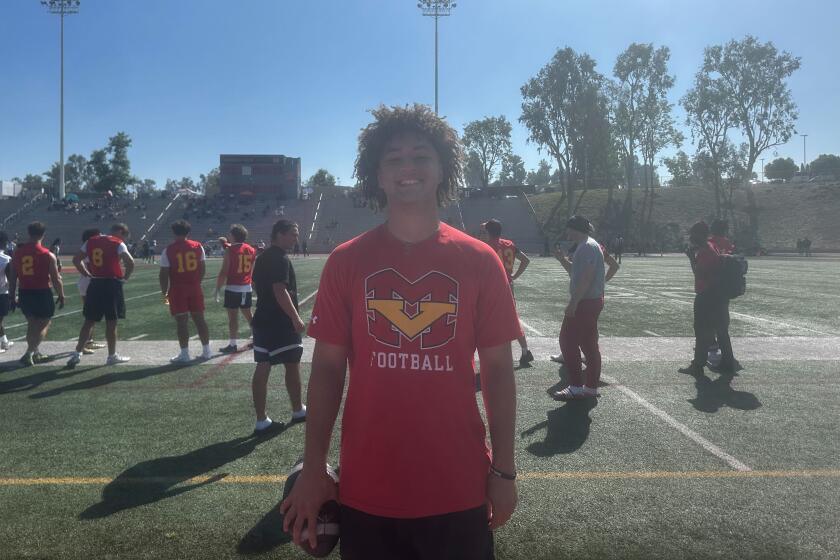Route to Esperanza Soccer Success? Sometimes It’s Volleyball
- Share via
On a chilly, midwinter afternoon at Esperanza High School, the No. 1 soccer team in the CIF Southern Section’s 3-A division is on the practice field, hard at work, playing . . . volleyball?
It’s all part of the coaching system of John Coppage, and it’s a system that has produced one of Southern California’s most successful programs.
Coppage says his system of set plays and team tactics, coupled with weekly respites of volleyball or flag football during practice, has helped make the team better.
“We’re a little unorthodox,” Coppage said. “Once a week, we usually play a little volleyball or flag football. We’re in an eight-team league and it’s a long season. They’ve already played about 20 games, not counting the summer league. You’ve got to give them a break once in a while.”
But other than giving the players a break, just how does volleyball help a soccer team?
“It’s fun, but you’re still learning,” defender Louis Cabral said. “You see, we have this problem of calling for the ball. The volleyball helps us with that because when the ball is in the air, you’ve got to call for it.”
The Coppage method is different, players and coaches say, and it works.
Roger Bryant, coach of South Torrance and president of the Southern California Soccer Coaches Assn., said he has seen similar methods work with other teams.
“I once had a team come in and play us that hadn’t touched a soccer ball in a week,” he said. “They blew us out because they were so hungry. I guess for them, it’s unusual, but successful.”
The Aztecs haven’t lost in 46 games (a 42-0-4 record). They’ve won 42 straight Empire League games and set Southern Section-record lows for goals allowed in a regular season (8) and in league play (5).
This season, league champion Esperanza is looking for its first 3-A championship. It plays Ganesha at home in today’s playoff opener. The Aztecs are 20-0-2 overall (12-0-2 in league).
Coppage is 62-2-6 since taking over the program three years ago, after coaching many of the same players in youth and club soccer programs. He credits his system as the key to Esperanza’s success.
“This team never finished above .500 or made the playoffs before I came here,” he said. (The Aztecs’ soccer program is nine years old). “A lot of our success is based simply on systems and tactics. We’re not just playing kickball out there.
“Let’s say we get the ball to the midfielder on the right side, that sets the whole thing in motion. Everybody knows his role and where he should be at that point, rather than just running up and down the field.”
Ed Quigley, the Aztecs’ team captain, said Coppage teaches a more disciplined game than most coaches.
“It’s more in-depth than other coaches I’ve had,” he said. “We know exactly what we’re supposed to do and where we’re supposed to be at all times. It’s much more organized.”
Bryant isn’t ready to adopt the techniques, but he can’t argue with their results.
“It’s phenomenal what he has been able to do over there, but I think they (set plays) are a waste of time,” he said. “Most coaches don’t devote an awful lot of time to them because it’s beyond the comprehension of a lot of players and the game is so unpredictable.”
The 46- and 42-game unbeaten streaks are considered unofficial Southern Section records because such marks have never been kept, according to Southern Section spokesman Scott Cathcart. Only a consecutive victory streak of 38, set by San Gabriel between 1970 and 1973 is recognized. (Esperanza has won four straight.)
But there’s nothing unofficial about the records to Coppage, who thinks the competition in the section has improved so much over the years that it’s virtually impossible for a team to go unbeaten and untied for an extended period.
“It’s beyond the realm of possibility,” he said. “It’s inconceivable the way things are now. Ties are just a part of the game.”
Ties even become part of the game when one team beats another. According to Southern Section rules, games won on penalty kicks in overtime are considered ties, but if it happens in a tournament such as the playoffs, the penalty-kick winner advances.
The players also think the coach’s personality is a key part of the system.
“He motivates us,” Quigley said. “That’s the biggest thing, just the way he pushes you, the constructive criticism.”
Said Coppage: “I’m a vociferous guy. I yell out there. But am I a Bobby Knight? No. I guess I’m more like a John Madden.”
Said Cabral: “He always has negative remarks during the game. It makes me mad when I hear them, and it makes me want to play better.”
Added Quigley: “When we’re doing bad he tells us. He really tells us. I can remember the Los Alamitos game this year, we were tied (1-1) at the half and he really dug into us at halftime. It got a lot of guys mad. We were so pumped up, we went out there and scored four goals and blew them out.”
Coppage’s coaching has helped develop some of his players into top college soccer prospects as well.
Heading to NCAA Division I programs this year are: Quigley (UCLA or UC Irvine), Chris Coscino (USC), Ken Georgy (Navy) and Paul Cieslek and Joe Andrulatis (Cal State Fullerton).
And if Coppage and Esperanza keep it up, they may wind up producing a few college volleyball prospects and some pretty good flag football players as well.
More to Read
Get our high school sports newsletter
Prep Rally is devoted to the SoCal high school sports experience, bringing you scores, stories and a behind-the-scenes look at what makes prep sports so popular.
You may occasionally receive promotional content from the Los Angeles Times.






